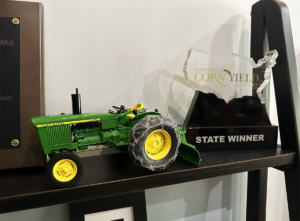Imagine your boss walks into your office, says your productivity is tops in the company, but he’s reducing your salary by 25%. That’s what it’s like being a farmer in 2024. We’re expecting to see the largest year-over-year drop in farm income in history, on the heels of a 19% decline in 2023. Farmers and ag lenders will be having very difficult conversations this winter. Borrowing capacities are sure to be restricted, or in some cases worse. The only saving grace is farmland values remain strong, growing 7.4% over the past two years. That’s good, because many farmers may need to live off their equity. The ripple effect extends well beyond the farm gate. This year’s projected $43 billion loss in farm income will profoundly impact rural communities, as well as industry suppliers.
Farmers will be extra motivated to do more with less in 2025. According to a recent study of ag economists, 62% believe it’s somewhat likely that farmers will reduce their fertilizer rates in 2025; 53% believe it’s somewhat likely they’ll reduce chemical rates; and 62% believe it’s somewhat or most likely that farmers will reduce their field passes. Huma is uniquely poised to help growers and retailers with these behavioral shifts.
- By making fewer passes, farmers must optimize the value of each trip across their field… soil- and crop-boosting products such as Zap, Huma Pro Mix, X-Tend, Vitol, Breakout make tank-mix partners that improve the performance of the products they’re mixed with.
- By cutting fertilizer rates (to in-turn cut costs), farmers must optimize nutrient availability. Carbon-based X-Tend significantly improves nutrient use efficiency and acts as a N inhibitor. X-Tend and dry humates make excellent companions when spreading or spraying fertilizers. They can enable growers to cut rates.
- By cutting chemical rates, farmers must optimize weed and pest control performance. X-Tend can help pesticides enter crops within one-hour, boost their performance and allow growers to apply crop protection products at the lowest labeled rate.
Who comes to mind when you think about segments of society who communicate digitally? Hunched-over Gen Zers staring deeply into the screens of their mobile phones as they parade around as zombies? Selfie-taking teens? Gamers? One of the last groups that probably come to mind is farmers. But based on our experience, farmers may be as attached to their mobile devices as the Tik-Tok generation. Traffic to www.huma.us shows that 85% of our site visitors come by way of mobile devices. Even though the average age of a US farmer is 58 years old. When you think about it, high mobile use by the world’s greatest profession makes sense. Mobile is what they are. They spend most of their waking hours constantly on the go: whether it’s on tractors and trucks, or in sheds, fields and pastures. Automated technology also creates the ideal venue for web surfing. The vast majority of row-crop farmers utilize GPS-guided auto-steer functions on their tractors, sprayers, pickers and combines. When you operate equipment hands-free, your hands are free to scroll. These usage patterns greatly impact how companies such as Huma create on-line experiences. Our new website was optimized for mobile, meaning it’s mobile first on how it displays images and content.
My corn is firing but still shows lots of green. It has still not reached black layer. Must be all that Huma product? It’s still taking in water, and I’m still watering it. We irrigated last Monday and again this weekend. We’ve had no rain this month.

Related Posts

This Week in Ag #15
“Your rows sure are straight.” Those may have been the most pride-filling words I ever heard. They were first spoken to me by one of my landlords, Orville Larson, the spring after my dad passed away and all farming operations fell entirely on me. Orville made a habit of driving out to his farm to see

This Week in Ag #29
We all do it. We track time by referencing memorable items that we or our family once possessed. “Back when he drove that blue Silverado”, or “when she had that yellow Labrador” are examples of how we recall events that shaped our lives. For farmers, those points in time are often defined by a tractor.

This Week in Ag #45
“Life.” That was my response when asked “What does soil health mean?” during an interview on The Big Show with WHO Radio last week. Whether it’s accelerating populations of soil microbes and worms, creating diverse biological communities or building biomass and aggregates, healthy soils are full of life. The trick is to stimulate and maintain biology in

